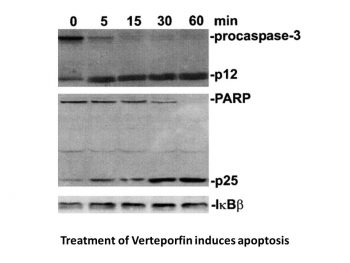
| Size | Price | Stock | Qty |
|---|---|---|---|
| 5mg |
|
||
| 10mg |
|
||
| 25mg |
|
||
| 50mg |
|
||
| 100mg |
|
||
| 250mg |
|
||
| 500mg |
|
||
| Other Sizes |
|
Purity: ≥98%
Verteporfin (also known as DB00460, CL318952, BPD-MA, BpdMA, Benzoporphyrin derivative monoacid ring A or BPD-MA) is a novel and potent second-generation photosensitizing agent derived from porphyrin in endothelial cells. It can be used for angiographic visualization of choroidal vessels and CNV.
| ln Vitro |
PDX cell screening was used to specifically select verteporfin. PhLO, PhLH, and PhLK had GI50 values of 228 nM, 395 nM, and 538 nM, respectively, causing 50% growth inhibition. In contrast, ALL-1, TCC-Y/sr, and NPhA1 had GI50 values of 3.93 μM, 2.11 μM, and 5.61 μM, respectively. Two of the three PDX cells' sensitivity to verteporfin was significantly decreased by GSH. In PDX cells, verteporfin lowers the potential of the mitochondrial membrane [1]. By suppressing YAP expression, verteporfin lowers the PTX resistance of HCT-8/T cells. When Verteporfin and NSC 125973 are treated together, they have a synergistic effect that inhibits YAP and decreases HCT-8/T cytotoxicity [2].
|
||
|---|---|---|---|
| ln Vivo |
BMS-354825 and verteporfin (10 mg/kg, csc) both dramatically decreased the percentage of leukemia cells, and their combination therapy also decreased the total amount of leukemia cells in the spleen [1].
|
||
| Animal Protocol |
|
||
| References |
[1]. Morishita T, et al. The photosensitizer verteporfin has light-independent anti-leukemic activity for Ph-positive acute lymphoblastic leukemia and synergistically works with BMS-354825. Oncotarget. 2016 Aug 2.
[2]. Pan W, et al. Verteporfin can Reverse the NSC 125973 Resistance Induced by YAP Over-Expression in HCT-8/T Cells without Photoactivation through Inhibiting YAP Expression. Cell Physiol Biochem. 2016;39(2):481-90. [3]. Donohue E, et al. The autophagy inhibitor verteporfin moderately enhances the antitumor activity of gemcitabine in a pancreatic ductal adenocarcinoma model.J Cancer. 2013 Aug 28;4(7):585-96 |
| Molecular Formula |
C41H42N4O8
|
|
|---|---|---|
| Molecular Weight |
718.79
|
|
| CAS # |
129497-78-5
|
|
| Related CAS # |
|
|
| SMILES |
C[C@]1(/C2=C/C(N3)=C4C)C(C(/C=C(C(C)=C/5C=C)\NC5=C/C6=N/C(C(CCC(OC)=O)=C6C)=C\C3=C4CCC(O)=O)=N2)=CC=C(C(OC)=O)[C@H]1C(OC)=O.C[C@]7(/C8=C/C(N9)=C%10C)C(C(/C=C(C(C)=C/%11C=C)\NC%11=C/C%12=N/C(C(CCC(O)=O)=C%12C)=C\C9=C%10CCC(OC)=O)=N8)=CC=C(C(OC)=O)[C@H]7C(OC)=O
|
|
| Synonyms |
|
|
| Storage |
Powder -20°C 3 years 4°C 2 years In solvent -80°C 6 months -20°C 1 month |
|
| Shipping Condition |
Room temperature (This product is stable at ambient temperature for a few days during ordinary shipping and time spent in Customs)
|
| Solubility (In Vitro) |
|
|||
|---|---|---|---|---|
| Solubility (In Vivo) |
|
| Preparing Stock Solutions | 1 mg | 5 mg | 10 mg | |
| 1 mM | 1.3912 mL | 6.9561 mL | 13.9123 mL | |
| 5 mM | 0.2782 mL | 1.3912 mL | 2.7825 mL | |
| 10 mM | 0.1391 mL | 0.6956 mL | 1.3912 mL |
*Note: Please select an appropriate solvent for the preparation of stock solution based on your experiment needs. For most products, DMSO can be used for preparing stock solutions (e.g. 5 mM, 10 mM, or 20 mM concentration); some products with high aqueous solubility may be dissolved in water directly. Solubility information is available at the above Solubility Data section. Once the stock solution is prepared, aliquot it to routine usage volumes and store at -20°C or -80°C. Avoid repeated freeze and thaw cycles.
Calculation results
Working concentration: mg/mL;
Method for preparing DMSO stock solution: mg drug pre-dissolved in μL DMSO (stock solution concentration mg/mL). Please contact us first if the concentration exceeds the DMSO solubility of the batch of drug.
Method for preparing in vivo formulation::Take μL DMSO stock solution, next add μL PEG300, mix and clarify, next addμL Tween 80, mix and clarify, next add μL ddH2O,mix and clarify.
(1) Please be sure that the solution is clear before the addition of next solvent. Dissolution methods like vortex, ultrasound or warming and heat may be used to aid dissolving.
(2) Be sure to add the solvent(s) in order.
|
 |